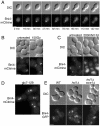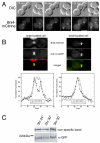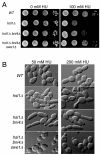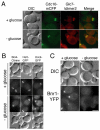Changes in Bni4 localization induced by cell stress in Saccharomyces cerevisiae
- PMID: 20197406
- PMCID: PMC2844317
- DOI: 10.1242/jcs.066258
Changes in Bni4 localization induced by cell stress in Saccharomyces cerevisiae
Abstract
Septin complexes at the bud neck in Saccharomyces cerevisiae serve as a scaffold for proteins involved in signaling, cell cycle control, and cell wall synthesis. Many of these bind asymmetrically, associating with either the mother- or daughter-side of the neck. Septin structures are inherently apolar so the basis for the asymmetric binding remains unknown. Bni4, a regulatory subunit of yeast protein phosphatase type 1, Glc7, binds to the outside of the septin ring prior to bud formation and remains restricted to the mother-side of the bud neck after bud emergence. Bni4 is responsible for targeting Glc7 to the mother-side of the bud neck for proper deposition of the chitin ring. We show here that Bni4 localizes symmetrically, as two distinct rings on both sides of the bud neck following energy depletion or activation of cell cycle checkpoints. Our data indicate that loss of Bni4 asymmetry can occur via at least two different mechanisms. Furthermore, we show that Bni4 has a Swe1-dependent role in regulating the cell morphogenesis checkpoint in response to hydroxyurea, which suggests that the change in localization of Bni4 following checkpoint activation may help stabilize the cell cycle regulator Swe1 during cell cycle arrest.
Figures







Similar articles
-
A Bni4-Glc7 phosphatase complex that recruits chitin synthase to the site of bud emergence.Mol Biol Cell. 2003 Jan;14(1):26-39. doi: 10.1091/mbc.e02-06-0373. Mol Biol Cell. 2003. PMID: 12529424 Free PMC article.
-
Protein phosphatase type 1 directs chitin synthesis at the bud neck in Saccharomyces cerevisiae.Mol Biol Cell. 2008 Jul;19(7):3040-51. doi: 10.1091/mbc.e08-02-0130. Epub 2008 May 14. Mol Biol Cell. 2008. PMID: 18480405 Free PMC article.
-
A septin-based hierarchy of proteins required for localized deposition of chitin in the Saccharomyces cerevisiae cell wall.J Cell Biol. 1997 Oct 6;139(1):75-93. doi: 10.1083/jcb.139.1.75. J Cell Biol. 1997. PMID: 9314530 Free PMC article.
-
Cell-cycle checkpoints that ensure coordination between nuclear and cytoplasmic events in Saccharomyces cerevisiae.Curr Opin Genet Dev. 2000 Feb;10(1):47-53. doi: 10.1016/s0959-437x(99)00051-9. Curr Opin Genet Dev. 2000. PMID: 10679396 Review.
-
The morphogenesis checkpoint: how yeast cells watch their figures.Curr Opin Cell Biol. 2003 Dec;15(6):648-53. doi: 10.1016/j.ceb.2003.09.001. Curr Opin Cell Biol. 2003. PMID: 14644188 Review.
Cited by
-
Chitin synthesis and fungal pathogenesis.Curr Opin Microbiol. 2010 Aug;13(4):416-23. doi: 10.1016/j.mib.2010.05.002. Epub 2010 Jun 8. Curr Opin Microbiol. 2010. PMID: 20561815 Free PMC article. Review.
-
No Chance to Survive: Mo-CBP3-PepII Synthetic Peptide Acts on Cryptococcus neoformans by Multiple Mechanisms of Action.Antibiotics (Basel). 2023 Feb 12;12(2):378. doi: 10.3390/antibiotics12020378. Antibiotics (Basel). 2023. PMID: 36830289 Free PMC article.
References
-
- Bertin A., McMurray M. A., Grob P., Park S. S., Garcia G., 3rd, Patanwala I., Ng H. L., Alber T., Thorner J., Nogales E. (2008). Saccharomyces cerevisiae septins: supramolecular organization of heterooligomers and the mechanism of filament assembly. Proc. Natl. Acad. Sci. USA 105, 8274-8279 - PMC - PubMed
Publication types
MeSH terms
Substances
Grants and funding
LinkOut - more resources
Full Text Sources
Molecular Biology Databases

